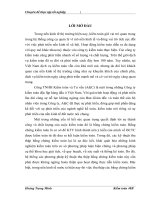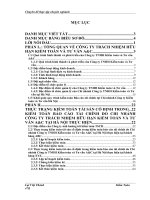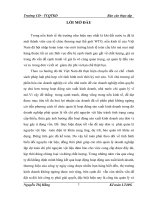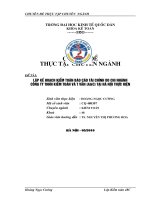Thesis_Nguyen Van A MBA....
Bạn đang xem bản rút gọn của tài liệu. Xem và tải ngay bản đầy đủ của tài liệu tại đây (467.7 KB, 110 trang )
Thesis for the Degree of Master
How to improve effectiveness of
marketing strategy in X Newspaper
Printing Joint Stock Company
September 2018
Department of Business Administration
Graduate School of Y University
by
Nguyen Van A
Thesis for the Degree of Master
How to improve effectiveness of
marketing strategy in X Newspaper
Printing Joint Stock Company
A thesis supervisor: AA
Thesis submitted in partial fulfillment of the
requirements for the Degree of Master
September 2018
Department of Business Administration
Graduate School of Y University
By
Nguyen Van A
3
To approve the submitted thesis for the
Degree of Master by name
Thesis Committee
Chair
(signature)
Member
(signature)
Member
(signature)
September 2018
Graduate School of Y University
4
To approve the submitted thesis for the
Degree of Master by name
Thesis Committee
Chair
(signature)
Member
(signature)
Member
(signature)
Member
(signature)
Member
(signature)
September 2018
Graduate School of Y University
ACKNOWLEDEMENT
Through two years of participation in Master of Business Administration
Class cooperated by Y University. I was delighted to see the enthusiastic
lecturers who taught me knowledge and whom I wanted to thank most
sincerely.
I would like to thank Prof. AA and Prof. BB, who instructed me to
complete
this
thesis.
I would like to thank Professors of Y University who was not afraid of
difficulties to go to Vietnam to teach me valuable knowledge about business
administration, through them I learnt more about a new culture - K culture.
I was also very happy to have opportunity to study with the other members
of the training program, who left me with lots of good and deep memories in
mind. Thank you for supporting me to complete this thesis.
Finally, I would like to thank the leaders of X Newspaper Print Joint Stock
Company, the Directors of Printing Companies in Northern region, Leaders
of Vietnam Printing Association who helped me in the research process.
Especially, I would like to thank the colleagues working in X Newspaper
Print Joint Stock Company who helped me gather documents for the study.
TABLE OF CONTENTS
ABSTRACT..................................................................................................viii
CHAPTER 1 INTRODUCTION................................................................- 1 1.1
Background and Motivation.......................................................- 1 -
1.2
Research Objectives...................................................................- 2 -
1.3
Research Subject and Scope.......................................................- 3 -
1.4
Research Methods......................................................................- 3 -
1.5
Scientific and practical meanings of the topic...........................- 4 -
1.6
Research Limitations..................................................................- 4 -
1.7
Structure of the thesis.................................................................- 4 -
CHAPTER 2 LITERATURE REVIEW.....................................................- 6 2.1 Definition and importance of Marketing strategy.............................- 6 2.1.1 Definition of Marketing.................................................................- 6 2.1.2 Definition of marketing strategy...................................................- 8 2.1.3 Importance of marketing strategy.................................................- 9 2.2 Targets in Marketing strategy of the enterprise................................- 9 2.2.1 Target on profitability..................................................................- 10 2.2.2 Target on generating position and power in business...............- 10 2.2.3 Ensuring safety in business.........................................................- 10 2.2.4 Ensuring work and income for the labours................................- 11 2.2.5 Protecting ecological environment.............................................- 11 2.3 Factors of business environment that affect Marketing strategy.....- 11 -
2.3.1 Macroscopic business environment............................................- 13 2.3.2 Sectorial environment..................................................................- 13 2.3.3 Internal business environment....................................................- 14 2.4 Contents of marketing strategy.......................................................- 14 2.4.1 Product strategy............................................................................- 14 2.4.2 Price strategy................................................................................- 22 2.4.3 Distribution strategy....................................................................- 25 2.4.4 Accesscibility in trading..............................................................- 27 2.4.5 Market encouraging strategy.......................................................- 28 2.4.6. Employee Customer Orientation................................................- 32 2.5 Brand of the company....................................................................- 34 CHAPTER 3 RESEARCH METHODOLOGY.......................................- 35 3.1 Research process.............................................................................- 35 3.2. Research Hypotheses and Model....................................................- 37 3.2.1. Hypotheses.................................................................................... - 37 3.2.2 Research Model............................................................................- 38 3.3. Survey Methods...............................................................................- 38 3.4 Questionnaire Development............................................................- 39 3.4.1 Primary questions.........................................................................- 39 3.4.2 Official questions.........................................................................- 39 3.5 Research Methods...........................................................................- 42 CHAPTER 4 DATA ANALYSIS AND FINDINGS...............................- 43 4.1 The status of marketing strategy in X Newspaper Printing Joint Stock
Company.................................................................................................- 43 4.1.1 Introduction.................................................................................. - 43 4.1.2 The diagram of organizational structure of the Company........- 44 4.1.3 Business results of the Company over the last 5 years............- 46 4.1.4
JSC
The status of the marketing strategy in X Newspaper Printing
- 47 -
4.2. Research Results and Discussions..................................................- 50 4.2.1 The Descriptive analysis of customer by gender........................- 50 4.2.2 Descriptive analysis of customers by age...................................- 51 4.2.3.Descriptive analysis of customers by qualifications..................- 52 4.2.4 Descriptive analysis of customers by income.............................- 54 4.2.5 Descriptive analysis of customers by workplace.......................- 55 4.2.6 Descriptive analysis of customers by transaction number.........- 56 4.2.7 The descriptive statistical analysis of customers by forms of
information access..................................................................................- 57 4.2.8 Overall descriptive statistical analysis of assessment of the
company business strategy.....................................................................- 58 4.2.9 Descriptive statistical analysis of the product quality criteria ...- 59 4.2.10 The descriptive analysis of the Company’s price criteria........- 60 4.2.11 Descriptive statistical analysis of the brand name criteria.......- 61 4.2.12 Descriptive statistical analysis of customer orientations of the
Company’s employees...........................................................................- 62 4.2.13 Descriptive statistical analysis of convenience criteria..........- 63 -
4.3 The scale analysis...........................................................................- 63 4.3.1
Assessing the scale reliability through the Cronbach’s Alpha
coefficient................................................................................................ - 63 4.3.2. Exploratory factor analysis..........................................................- 71 4.4 The regression analysis..................................................................- 78 CHAPTER 5 CONCLUSIONS AND SOLUTIÓNS...............................- 81 5.1.
Conclusions.................................................................................- 82 -
5.1.
Solusions.....................................................................................- 82 -
5.2.1 Completing the product strategy................................................- 82 5.2.2. Improve the price strategy..........................................................- 84 5.2.3. Improve the company's brand name..........................................- 86 5.2.4 Improve the customer orientation of employees.......................- 86 5.2.5 Accessibility trading...................................................................- 86 5.3 Implications..................................................................................... - 87 5.4 Future Research Directions.............................................................- 875.5 Summary of the chapter..................................................................- 87 -
REFERENCES.........................................................................................- 89 APPENDICES..........................................................................................- 91 -
LIST OF TABLES
[Table 3-1] Questionnaire Instruments......................................................- 40 [Table 4-1] The business results of the Company for the last 5 years......- 46 [Table 4-2] The customer classification by gender...................................- 50 [Table 4-3] The customer classification by age.........................................- 51 [Table 4-4] Customer classification by qualifications..............................- 53 [Table 4-5] Customer classification by income.........................................- 54 [Table 4-6] The customer classification by workplace.............................- 55 [Table 4-7] The customer classification by transaction number...............- 56 [Table 4-8] The customer classification by forms of information access.- 57 [Table 4-9] The overall descriptive statistics of the company’s business
strategy.......................................................................................................- 58 [Table 4-10] The descriptive statistics of the product quality criteria......- 59 [Table 4-11] The descriptive statistics of the Company’s price criteria.. .- 60 [Table 4-12] The descriptive statistics of the brand name criteria............- 61 [Table 4-13] Descriptive statistics of the employee’s customer orientation. .- .
62 [Table 4-14] The descriptive analysis of convenience criteria................- 63 [Table 4-15] The Cronbach's alpha coefficient of the company marketing
strategy scale..............................................................................................- 64 [Table 4-16] Cronbach’s Alpha of the marketing strategies....................- 64 -
[Table 4-17] The Cronbach’s Alpha of the product quality scale............- 65 [Table 4-18] The Cronbach’s Alpha coefficient of the product quality...- 65 [Table 4-19] The Cronbach’s Alpha coefficient of the product price scale - 66
-[Table 4-20] Cronbach’s Alpha of the product price...............................- 66 [Table 4-21] Cronbach’s Alpha of the company brand name scale.........- 67 [Table 4-22] Cronbach’s Alpha of the company’s brand name scale.......- 67 [Table 4-23] Cronbach’s Alpha of the customer orientation scale............- 68 [Table 4-24] Cronbach’s Alpha of the customer orientation scale............- 69 [Table 4-25] Cronbach’s Alpha of accessibility scale...............................- 70 Table 4-26 Cronbach’s Alpha of the Accessibility scale..........................- 70 [Table 4-27] KMO and Bartlett’s test.......................................................- 72 [Table 4-28] Total Variance Explained.....................................................- 73 [Bảng 4-39] Rotated Component Matrixa...............................................- 76 [Table 4-30] Model Sumary.....................................................................- 80 [Table 4-31] Model Sumary.....................................................................- 81 -
LIST OF FIGURES
[Figure 2-1] Factors of business environment that affect Marketing strategy
...................................................................................................................- .12 [Figure 2-1] Model of 5 competitive forces by M.Porter........................- 14 [Figure 3-1] Research process...................................................................- 36 [Figure 3-2 ] Research Model....................................................................- 38 [Figure 4-1] The model of organization of X Newspaper Printing Joint Stock
Company....................................................................................................- 45 [Figure 4-2] The chart of customer classification by gender...................- 51 [Figure 4-3] The chart of customer classification by age.......................- 52 [Figure 4-4] The chart of customer classification by qualifications........- 53 [Figure 4-5] The chart of customer classification by income...................- 54 [Figure 4-6] Charts classify customers according to the customer's
workplace...................................................................................................- 55 [Figure 4-7] The chart of customer classification by the transaction number
....................................................................................................................- 56 [Figure 4-8] The chart of customer classification by forms of information
access..........................................................................................................- 57 -
ABSTRACT
HOW TO IMPROVE EFFECTIVENESS OF
MARKETING STRATEGY IN X NEWSPAPER
PRINTING JOINT STOCK COMPANY
NGUYEN THI HA
Department of Business Administration
Graduate School
Soongsil University
In the context of the market economy and the current trend of opening integration, but many companies produce the same products leading to
competition which is inevitable. So in order to be able to withstand and
survive, each business must have good marketing strategies which create
strong brand - is the key to make differences. Building an effective business
strategy is a big advantage of businesses currently. With the thesis topic:
"How to improve effectiveness of marketing strategy in X Newspaper
Printing Joint Stock Company" is derived from the real situations above.
So, what factors help the company improve the effectiveness of its
marketing strategy? What are the solutions? These are two questions in this
study the author focused on answering based on the analysis of the current
marketing strategy in X Newspaper Printing Joint Stock Company, which
aimed to understand the real situations and problems from which they were
the basis to propose solutions to improve the efficiency of the company’s
marketing strategy.
This study used quantitative research methods through analyzing economy,
survey of 250 questionnaires from customers who had ordered goods in the
company. The research results showed that product quality, product price,
company brand, employee customer orientation, well-trading location ...
were the urgent and important issues for improving effectiveness of
marketing strategy in the company. Therefore, when the company focused
on solving these problems, it meant that the company's marketing strategy
would be more effective, and then it would withstand, survive and grow in
the highly competitive market.
Key words: Marketing Strategy, Product Price, Company Brand,
Employee Customer Orientation, Accessibility
CHAPTER 1 INTRODUCTION
1.1 Background and Motivation
Nowadays, printing technology is developing very strongly, the number of
enterprises operating in this market is becoming higher and higher with
greater scale and diverse forms, the competition between them is also fiercer.
In order to exist and develop, each enterprise must establish a firm position
in the market, which requires suitable business strategies, especially the
marketing ones.
Marketing is an important, key activity of the enterprises which affects all
stages of supplying input materials, planning production and consumption. It
not only promotes consumption but also creates value of the enterprise.
X Newspaper Printing Joint Stock Company is a prestigious enterprise in X
province which is gradually asserting itself throughout the country. X
Newspaper Printing trademark has been attracting customers inside and
outside the province. Such success comes from current fairly good
management. However, in order to aim to sustainable and long-term
development, to create good a nationwide trademark, a long-term marketing
strategy must be planned and aimed to promoting value, upgrading
trademark of the Company.
For such reasons, I chose the topic: “How to improve effectiveness of
marketing strategy in X Newspaper Printing Joint Stock Company” for my
thesis.
1.2 Research Objectives
- To systematize theoretical bases and actual situation of marketing strategy
in X Newspaper Printing JSC
- To analyze factors affecting Marketing strategy of the Company recently
- To poll the opinion of customers basing on survey result, to evaluate
features and trends of the market in near future
- To propose solutions for enhancing effect of Marketing strategy in the
Company
Specific targets of the research:
+ To find out problems, causes, restrictions of current strategies in the
Company basing on the theory of marketing strategy and actual situation of
the strategies on product, price, distribution, promotion.
+ Among the factors affecting marketing strategy of the Company, the
author raises some questions to interview experts (Directors of printing
companies, Head, Deputy-Head of Printing Association) and form a
questionnaire about importance of the factors affecting marketing strategy of
the Company, then find out 5 most important ones (5 independent variables:
product quality; price; trademark of the Company, customer orientation of
employees; Accessibility trading)
+ To form a questionnaire for customer survey then evaluate actual
situation of marketing strategy in the Company through 5 independent
variables.
1.3 Research Subject and Scope
Subject of this research is the actual situation of Marketing strategy in X
Newspaper Printing JSC in 5 recent years
1.4 Research Methods
Following methods are applied:
- Document collection and analysis.
- Investigation.
- Mathematic statistics.
- Using secondary data and reports of X Newspaper Printing Joint Stock
Company Data collection: Applying suitable methods on primary data
collection simultaneously (through actual investigation by questionnaire)
and secondary data collection (at provincial departments, General
department of statistics, X Department of statistics, books, newspapers,
magazines, internet…). Such information has been collected, analyzed under
the combination of theory and practice. Survey questionnaires have been
analyzed by SPSS software version 16.0.
Data analysis: The author combines analysis, evaluation on the factors
affecting marketing strategy of the Company by descriptive statistic tools of
SPSS software as the bases for determining causes and proposes solutions
for improving effect of mix marketing strategy in X Newspaper Printing
JSC.
1.5 Scientific and practical meanings of the topic
To improve the capacity on scientific research, to supplement theoretical
and practical knowledge for the author of this research.
Result of research topic will be the basis for X Newspaper Printing JSC to
consult and apply during improvement of effect and completion of
Marketing strategy.
1.6 Research Limitations
- There may be some certain errors during primary data analysis due to
limited number of questionnaires and law of large number.
- Because marketing activities of X Newspaper Printing Joint Stock
Company are chosen as the sample for this research, all solutions given here
can be applied for the Company only.
- The thesis analyzes actual situation and give out some solutions on the
basis of marketing theory. It will contain unilateral, incomprehensive view
although the author has consulted, referred some theories on corporate
finance, human resource administration…
1.7 Structure of the thesis.
This thesis consists of 5 chapters:
Chapter I:
Introduction
Chapter II:
Theoretical bases
Chapter III:
Research method
Chapter IV: Result of research and discussion
Chapter V:
Conclusion and Solution
CHAPTER 2 LITERATURE REVIEW
2.1 Definition and importance of Marketing strategy
2.1.1 Definition of Marketing
According to some related documents, the term “Marketing” first appeared
in US in the early 20th century and put into English dictionaries in 1944. In
terms of structure, “marketing” consists of the origin “market” and suffix
“ing” which means the movement and ongoing process of the market.
So how should Marketing be understood?
- According to definition of I. Ansoff – a professional marketing researcher
of the United Nation:
Marketing is the science of operating all business activities from phases of
production to consumption basing on variable demand of the market or, in
other words, market-oriented.
- According to America Marketing Association (AMA) in 1960:
Marketing means all the business activities directing flows of goods and
services provided by suppliers to the consumers and users.
- According to UK Marketing Institute:
Marketing is the processing organizing and managing overall business
activities from discovering and changing purchase power of consumers to
actual demand for a specific product line to manufacturing and delivering
products to end-users in order to ensure that the company will gain expected
profit.
- According to Malaysia Management Academy:
Marketing is the art of combining, utilizing essential resources to discover,
create, satisfy and raise the demand of customers then generate profit.
- According to John H.Crighton (Australia):
Marketing is the processing supplying accurate products, channel or flow
of goods in accurate time and at accurate position.
- According to V. J. Stanton:
Marketing is an overall system of business activities which is expressed in
plan, price, expansion and distribution of goods, services in order to satisfy
the demands, desires of current and potential customers.
- According to Peter Drucker (US):
Marketing means all business works in the viewpoint of consumers.
- Definition of Philip Kotler:
Marketing is a business activity that satisfies demand and desire of
customers by exchanging method.
Or: Marketing is a process of economic and social management upon
which organizations and individuals may attain what they need and desire
through creation and exchange of products and values with the others.
- Some definitions of entrepreneurs:
Marketing is a familiar, open-minded smile of entrepreneurs to their
customers or consumers.
Marketing is finding the demands and satisfying them in the best way, all
business activities must base on the market.
In summary:
- Marketing is an activity aimed to better satisfy the demands of
consumers.
- Marketing is not a phenomenon, it is a repeated process started from
researching market, seeking demand until finding out the products which can
satisfy such demands. This focuses that the process is repeated, which means
that research on market and demands of customers is continued in order to
satisfy such demands better and better.
- Marketing is the overall of methods, solutions during business process
started from market research, production planning (what, how many,
how?...) and assessment on products, services, establishment of distributing
channels and promotional activities to support business activities in
satisfying the demands discovered in the phase of market research.
2.1.2 Definition of marketing strategy
Marketing strategy is a system of large policies and methods of deploying
production and business activities in order to perform expected targets of the
enterprise: trademark, market share... In order to succeed, all enterprises
appreciate marketing activity adapting to actions of the market and potential
market.
2.1.3 Importance of marketing strategy
Competition on the market is becoming fiercer and fiercer, now the
enterprises not only adapt to actions of the market but also plan marketing
strategy besing experience, intelligence and stuff of businessmen.
Marketing strategy defines immediate and future orientation of the
enterprise so that the administrators will consider and make decisions on
implementation of policies and marketing methods in the most effective way.
Marketing strategy shows the administrators great opportunities and
possible challenges in business activities, then forecasts and prepares
suitable conditions to utilize great opportunities and improve, restrict
challenges to the enterprises.
Marketing strategy helps the administrators to increase turnover and save
costs so that they can attain the most effective result of business activity.
Marketing strategy helps the administrators to build a system of methods to
promote their positions on the market, create cooperative relations with other
enterprises as well as restrict competing ability of competitors.
2.2 Targets in Marketing strategy of the enterprise
All the enterprises investing, trading in the market aspire to maximize their
profits. Therefore, they need to set some targets to make it convenient for
planning strategies and completing given plan. The target of marketing
strategy is the ability of creating profits, generating position and power,
ensuring safety in business and works, income for labours, protecting
ecological environment.
2.2.1 Target on profitability
Profit is an important target for production and business activities, it is also
the final target of many enterprises. Profit helps the enterprises to reproduce,
expand the scale… and pay corporate income tax as well as other payables
to the state.
In order to achieve such target, enterprises must have adaptive business
strategy and continuous efforts to innovate technology, technique, improve
management of production and business activities suitably for capacity of
enterprises and demands of the market.
2.2.2 Target on generating position and power in business
Generating position and power to expand market share and seek more
profits, sell more products, attain more market segments and satisfy greater
demand. Then the enterprise will collect and concentrate capital faster,
contribute to generation of new position and power.
2.2.3 Ensuring safety in business
Safety brings success – this is the top concern of enterprises. However,
risks in market economy are unavoidable, although the enterprises have









